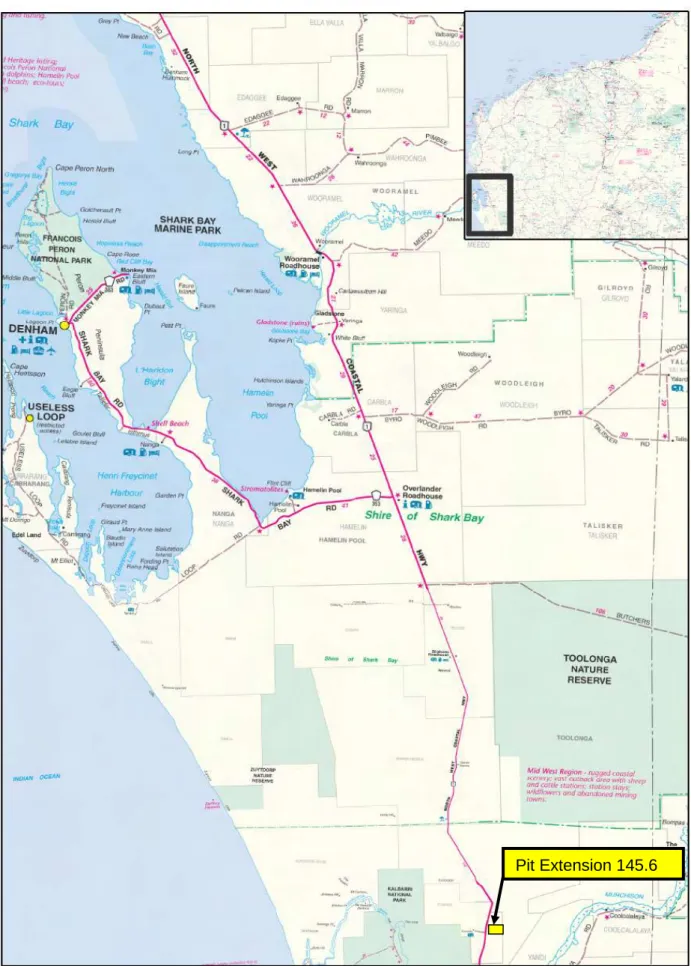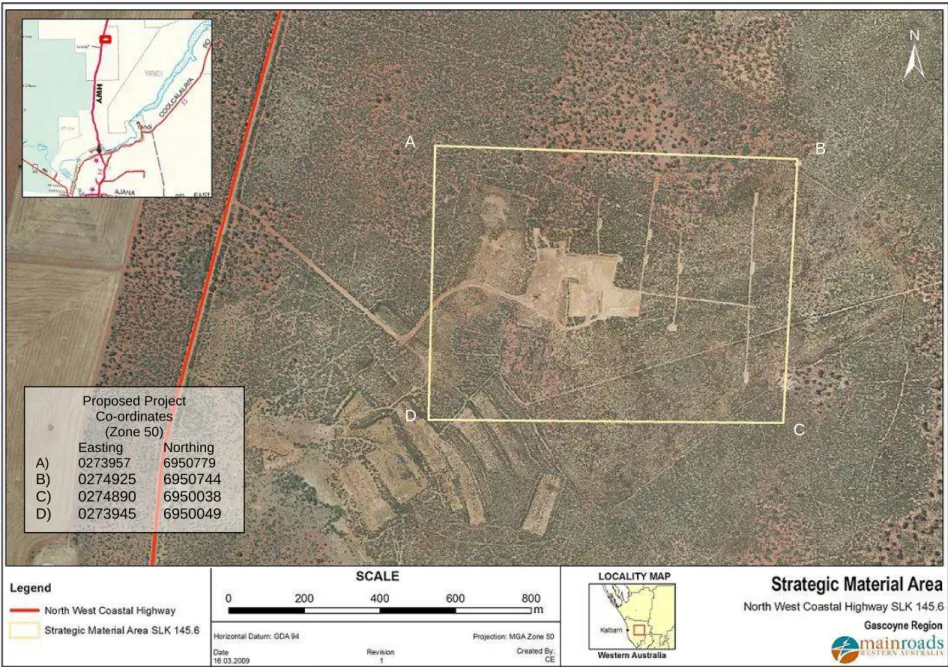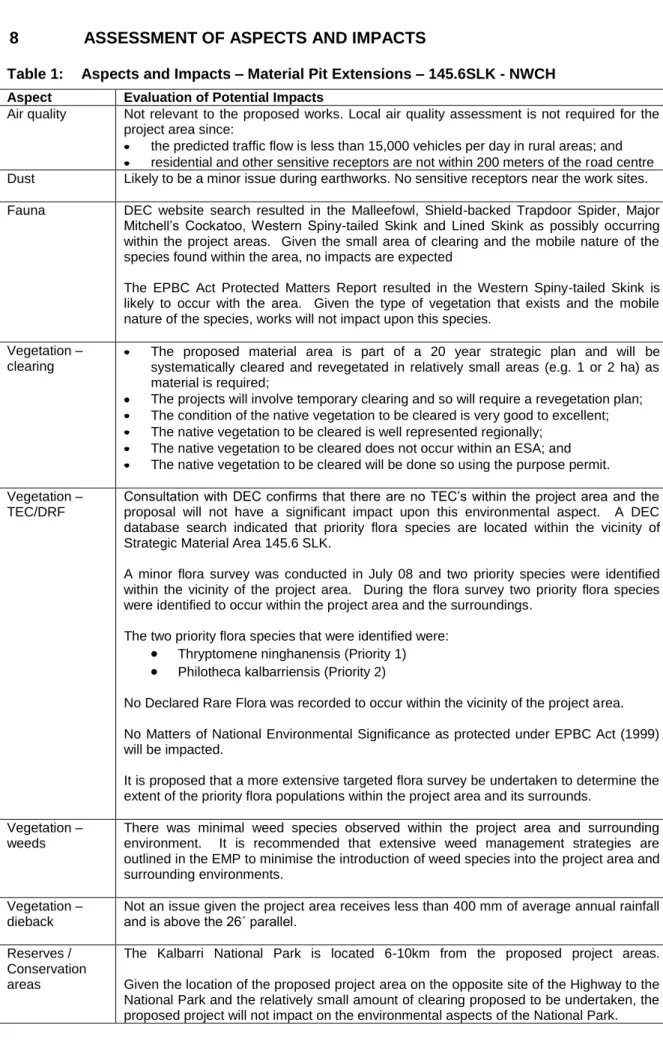G Department of the Environment and Heritage Database Search H Main Roads WA – Reforestation Plan for Pastoral Areas. This potential material area has been identified as part of the regional strategic material plan and is located within the Eurardy station. Strategic material area SLK 145.6 is located within the Eurardy station, approximately 30 km north of the Murchison River.
A preliminary assessment of the project area and its potential constraints was undertaken by reviewing a number of records managed by government agencies (and consulting where necessary). The location of wetlands within the project area was determined using the Commonwealth Department of Environment and Heritage (DEH) mapping tool and the Department of Environment and Conservation (DEC) Geographic Data Atlas mapping tool. http://maps.dec.wa.gov.au/idelve/doedataext/). Department of Indigenous Affairs (DIA) research. http://www.dia.wa.gov.au/Heritage/SitesSurveysSearch.aspx) database was undertaken to determine if the project area contained any Aboriginal heritage sites, refer to Appendix E.
The Commonwealth Department of the Environmental and Heritage (DEH) mapping tool and the Department of Environment and Conservation (DEC) Geographic Data Atlas mapping tool were used to determine whether the project area supported major lakes, rivers or wetlands or was adjacent to major lakes , rivers or wetlands or declared areas. An on-site survey of the project areas was conducted to determine if there are known populations of declared plants or significant weeds in or adjacent to the project area.

7 CLEARING OF NATIVE VEGETATION
Assessment against Clearing Principles
Environmentally Sensitive Area (ESA)
Clearing within an Environmentally Sensitive Area (ESA)
Yes/
Comments Does the area to be cleared occur within
8 ASSESSMENT OF ASPECTS AND IMPACTS
A search of the Australian Heritage Places Inventory, Heritage Council of Western Australia and the Shire of Carnarvon's Municipal Heritage Inventory online databases indicated that there are no heritage listed sites present in the currently proposed work areas. A search of the DIA database did not identify any known sites of Aboriginal heritage interest in the vicinity of the project areas at SLK 145.6. Site visit confirmed that the proposed works will not disturb or interrupt any natural drainage and surface runoff patterns.
Visual amenities The proposed works will result in minor and short-term visual impacts during construction. Provided that traffic management and signage to main road standards are used, none of the proposed works pose any significant risk to public safety. Contamination Given the relatively shallow nature of the earthworks required, there appears to be no risk of any significant contamination issues.
The self-evaluation of the WAPC (Planning Bulletin 64) shows that no further soil investigation is required for the project. Since the proposed works are entirely within the land allocated to major roads, no further changes to the local government planning plan or regional plan are required.
9 DECISION TO REFER
Appropriate site completion treatments, including rehabilitation, will result in an improvement in local visual amenity.
10 STAKEHOLDER CONSULTATION
11 ENVIRONMENTAL MANAGEMENT PLAN
Communication Plan
12 MONITORING
13 CONTINGENCY MEASURES
14 AUDITING
15 REFERENCES
Dumping of materials anywhere outside the hard zones will be recorded as an environmental incident. The location of hotspots will be identified prior to the commencement of field activities in consultation between the Project Manager and the Main Roads Environment Officer. Further discussions on hotspot locations will take place as needed throughout the project timeframe.
All environmental incidents will be investigated by an Environmental Officer or Major Roads Project Manager, who will ensure that all corrective actions are completed. Construction work will be carried out in accordance with AS 2496-1981 Guide to Noise Control at Construction, Maintenance and Demolition Sites. The project areas, including installation areas, are kept tidy at all times.
All waste on the project will be placed in lidded containers and disposed of at an approved landfill. Inspection of all storage and service areas, spill kits and bunds will be carried out at regular intervals throughout the project timeframe. Inspections of hard standing area will be carried out before the start of construction and throughout the course of the project.
All environmental incidents will be investigated by the Environmental Officer, who will ensure that all corrective actions are completed. A compensation package will be implemented in consultation with DEC and other stakeholders to minimize impacts to priority flora populations. All personnel will be made aware of the location of priority flora species within the project area and management strategies will be implemented to avoid undue impacts to any of the priority flora populations.
All personnel working on the project will be made aware of the priority flora populations and the necessary management strategies. All personnel working on the project will be made aware of the requirements not to harm or kill any animals during the course of the project during site induction and that animals must be allowed to leave the project site. All staff working on the project will be made aware of the requirements relating to Aboriginal heritage sites during site induction.
Monitoring of replanting works will be in accordance with Main Roads Replantation Plan for Pastoral Areas. All required records relating to the clearing of native vegetation under Main Roads Purpose Permit (CPS 818/4) will be maintained.
APPENDIX A
Low Impact Environmental Screening Checklist
APPENDIX B
Project Site Photos
Main Roads Western Australia Page 35 of 63 Photo 1: Pit Extension 145.6 SLK – North West Coast Highway – North. Main Roads Western Australia Page 36 of 63 Photo 3: Pit Extension 145.6 SLK – North West Coastal Highway – East View.
APPENDIX C
DEC’s Threatened Flora and Fauna Database Searches
WA herbarium Database Search
APPENDIX D
Non-Indigenous Heritage Sites
APPENDIX E
Indigenous Heritage Sites
APPENDIX F
WAPC’s Acid Sulfate Soil Mapping
APPENDIX G
Department of the Environment, Water, Heritage and the Arts Database Search
APPENDIX H
Main Roads WA – Revegetation Plan for Pastoral Areas
All vegetation will be cleared from the work area and non-weed infested vegetation will be stored. Stored vegetation will be located in a manner that prevents damage to adjacent vegetation by machinery. Weed-infested vegetation will be disposed of in an appropriate location and not used for replanting purposes.
Weed Control: Adequate weed control shall be performed when weeds are present, both prior to topsoil stripping and when weeds are placed on or between stockpiled materials. Where possible, weeds will be removed before or when they are in flower, and before planting. Where works are adjacent to good quality vegetation where weeds from within the project area are likely to spread and result in environmental damage to the adjacent area, those weeds will be controlled annually by 12 December 2010 .
Project areas will be ripped to a minimum depth of 200mm deep with rip lines approximately 300mm apart. Overburden and then topsoil will be uniformly and evenly distributed over the disturbed areas of the pit. Depending on the slope of the drainage lines in the well, small swabs will form from the topsoil to reduce the rate of erosion and promote the deposition of seeds.
The entire existing pit floor, including drainage lines, will be split to a depth of 300-500mm deep with split lines spaced 500-800mm apart (if the material in the pit can be split). All accumulated vegetation will be spread along the contour and the pit floor to help promote seed deposition and reduce erosion rates. After replanting works, replanting areas will be inspected annually for a minimum of two years to monitor and control weeds and to measure the effectiveness of replanting works.
When unwanted weed leaf cover exceeds 25% after the initial two year period, further actions will be implemented to monitor and control these weeds. The additional monitoring and weed control will be carried out annually until 12 Dec 2010 or until the unwanted weed leaf cover falls below 25%, whichever is sooner. Post-replanting site inspections will be carried out annually for a minimum of two years to monitor unwanted weeds and measure the effectiveness of replanting works.
Vegetation Clearing Assessment Report
MRWA Vegetation Clearing Assessment Report
Property details
Area under assessment
Avoidance/Minimise clearing
Main Roads Western Australia Page 62 of 63. b) Native vegetation must not be cleared if it is the whole or part of, or necessary for the maintenance of, a significant habitat for fauna native to it.
Western Australia
Main Roads Western Australia Page 63 of 63. g) Native vegetation should not be cleared if the clearing of the vegetation is likely to cause appreciable land degradation.
OFFICER PREPARING REPORT Crystelle Evangelista (Environment Officer)


